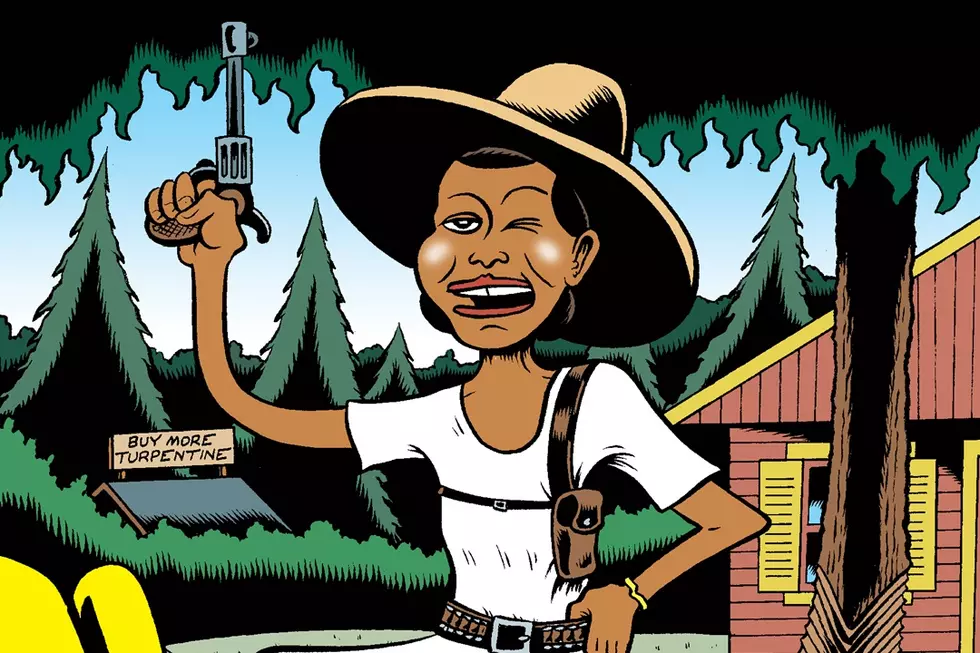
Read This Comic: Rich Burlew’s ‘Order Of The Stick’
I've been a fan of Rich Burlew's Order of the Stick for almost as long as the comic's existed. Over the course of the strip, clocking it at almost a thousand installments, Burlew's been building a complex fantasy universe, launched a record-breaking Kickstarter, and done everything from gags about obscure rules changes in Dungeons and Dragons to sprawling commentary on the nature of Good and Evil, in both roleplaying game and philosophical terms. Even if you're not the kind of person who likes sitting around a table throwing around 20-sided dice and figuring out your Base Attack Bonus on scratch paper, it makes a pretty compelling read.
As the most recent storyline comes to a close, though, all those things have come together in a way that works perfectly. It's better than it's ever been in the past ten years, and a huge part of that is the way that Burlew has been using stick figures battling with swords as a platform to examine the nature of fiction, and how playing with the rules of a narrative can lead to some beautiful storytelling.
When you get right down to it, that was probably a necessary direction for the strip to go in. Order of the Stick has the unique distinction of being, in a lot of ways, a parody comic that somehow managed to outlast the thing that it was parodying. Looking back from today, those early strips about weapon size rules and the complexities of leveling up seem almost quaint, if only because the game system they're goofing on has gone through a major revision, leaving the subject matter as the same kind of weird little footnote in the world of RPGs that it is in the sprawling saga that became the focus of the comic. Of course, all that stuff is still there, with casual conversations about +5 swords and plot points based around how many spells per day a capital-W Wizard can cast, and to be honest, it's still a major part of the appeal. When I talked to him about the Kickstarter and how it kept on shattering expectations with every new stretch goal, Burlew mentioned that cultivating an audience of gamers meant that he was appealing directly to people who were hardwired to want to see numbers rise and unlock new rewards, and I suspect that he was only half-joking.
In the comic, though, all those rules are really just doing the same thing that they do in a tabletop RPG: they form the background for a story. From a very early point in the strip's run, Burlew made it clear that he was doing more than just a gag strip about halflings. The seeds of the greater plot, the one that's taken up the majority of the past decade, were dropped pretty early on, and everything has flown from that. The thing is, once you start acknowledging that your world is built around a set of rigidly defined rules, it becomes clear that your story is built on the same kinds of laws. That's what sets the past year's worth of strips apart, even for a strip that's consistently gotten better for the entire time it's been around.
Instead of cracking jokes about the rules of the game, Order of the Stick has started examining the rules of its own narrative, and it's been fantastic.
Again, that's something that's always been a part of the strip, especially when the focus is on Elan, a bard whose chief contribution to the party comes from his understanding of dramatic structure. That's something that the subject matter lends itself to pretty well, too, considering how many games of D&D are based around recreating the feelings that players got from Tolkien or Howard or, God help you, Salvatore, and Burlew's always embraced those clichés for all they were worth. I mean, one of the first major storylines -- the first major storyline, now that I'm thinking about it -- was about a gang of Evil Opposites led by Elan's Evil Twin Brother, and if that's not playing right up to the expected beats of a story, I don't know what is. Even the more recent stories have been built around consciously retreading the same ground, this time with Elan's evil father, Tarquin, who's so on the nose that he's more or less named after the bad guy from Star Wars.
Incidentally, one of my favorite recurring gags in the entire strip has been the relatively subtle practice of embracing generic fantasy tropes by giving locations the most obvious possible names. They have an adventure in the city of Cliffport, for example, which is on a cliff by the ocean, and at one point the gang makes a trek through the Wooden Forest. It cracks me up every time.
The trick is that Burlew has twisted those clichés just enough that instead of feeling repetitive, the familiarity works, both on its own and in how it sets up pivotal moments where the characters defy those expectations. Roy's death (uh, spoiler warning for something that happened like 500 strips ago) is a great instance of the latter, but it's far from the only one, and they've been especially on point in recent strips.
The storyline that's just finishing up now -- and which stretches back about a hundred strips, or more if you really want to get technical about drawing lines between chunks of an ongoing narrative -- is a pretty incredible testament to how fresh those same old bits and pieces can feel when they're arranged in the right order. Burlew has laid out plots for years that, on the surface, are so cliché that it's easy to see where they're going from the moment they're introduced, but in practice, they still have this sense of dread. The readers know where it's going, in some cases the characters even know where it's going, but they can't stop it. It works because we're all on the same page with these clichés, and that brings a sense of dread to it.
I think it's fair to say that "inevitability" is a pretty big theme of the most recent storyline, manifesting in different places as the inevitability of betrayal when villains ally with each other (something that happens twice with one pair of bad guys and manages to be shocking both times), the inevitability of death, the way that a person will inevitably react according to the core of their personality even under the most extreme circumstances, and even the inevitability of actions having consequences.
That last one, Vaarsuvius being dragged down to Hell by demonic forces right at a crucial moment, is probably the most telegraphed moment in comics history, to the point where the demonic (and devilish, and diabolical) forces responsible for it lay out exactly what they're going to do in no uncertain terms when Vaarsuvius makes the deal a couple hundred strips before. They -- and Burlew -- tell you well in advance that it's going to happen, but that's what makes it work. The sense of dread, the realization that there are consequences that can't be avoided, even in this quite-literal-fantasy world. It all happens because people are acting according to the personalities and natures that have been built and refined over years of storytelling.
Of course, it doesn't hurt that the strip still manages to be consistently funny and exciting even while it's exploring the fatalistic nature of narrative structure, but it really has surpassed itself here. It's not just that it's smart, or that it's funny, or that it's dealing with heavy stuff in a way that makes you forget you're reading a comic about stick figures that routinely use the phrase "magic missile." It's that Burlew does it all at once, in a way so clever that it makes the meta-commentary as exciting as the swashbuckling adventure.
Set aside some time and catch up. It's worth it.
More From ComicsAlliance
![Rich Burlew on the Record-Breaking Success of the ‘Order of the Stick’ Kickstarter [Interview]](http://townsquare.media/site/622/files/2012/02/ootskickstarter01.jpg?w=980&q=75)




![Five Stars: Starting At The End With Jeff Smith [Interview]](http://townsquare.media/site/622/files/2017/03/FiveStars-Smith.jpg?w=980&q=75)
![Take Me to Your Teacher: Trevor Mueller and Gabo Discuss ‘Albert the Alien’ [Webcomic Q&A]](http://townsquare.media/site/622/files/2017/03/0ALBERTVOL3_COVER_notitle-copy.jpg?w=980&q=75)
![‘Runaways’ Meets ‘Coraline’ in Cait May and Trevor Bream’s ‘Irregular’ [Webcomic Q&A]](http://townsquare.media/site/622/files/2017/03/Irregular_Banner.jpg?w=980&q=75)

